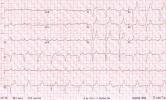II. Pathophysiology
- Impaired conduction in Atria, AV Node or His-Purkinje
III. Types: First Degree Atrioventricular Node Block
- Causes
- Normal finding in >1% of healthy adults
- Inferior wall ischemia (right Coronary Artery) if onset in acute presentations
- Increased vagal tone (responds to Atropine)
- Hypothyroidism
- Medications
- Findings
- Consistently Prolonged PR Interval >0.20 seconds
- Each P Wave is conducted and associated with a QRS Complex
- Treatment
- None needed
IV. Types: Second Degree Atrioventricular Node Block
- Also known as Sinoatrial Exit Block
- Type I Second Degree Atrioventricular Node Block
- Known as Mobitz I AV Block or Wenckeback Conduction
- Acute condition affecting AV Node
- Most often due to excess vagal tone
- EKG Findings
- Progressive increase PR Interval until beat/QRS Complex dropped (non-conducted P Wave)
- Cycle repeats after beat dropped, with PR Interval resetting aftet the dropped beat
- Causes: Functional, reversible defects
- Inferior Myocardial Ischemia
- Rheumatic Fever
- Digitalis Toxicity
- Increased vagal tone
- Beta Blocker
- Response to Maneuvers
- Bradycardia improves in response to Atropine and Exercise
- Worsens with carotid massage
- Type II Second Degree Atrioventricular Node Block
- Known as Mobitz II Block
- Chronic condition affects infranodal conduction path
- Intermittent conduction defect with a consistent frequency of non-conducted P Wave
- Described as a ratio (e.g. 3:2) of P Waves to QRS Complexes
- EKG Findings
- Regularly dropped QRS waves at consistent interval is typical
- Other findings
- No change in PR Interval (remains constant unlike Mobitz 1)
- RR interval is constant, except for the missed beat, which is then double the PP interval
- QRS Duration does not differentiate Mobitz 1 from 2 (either may have a normal or prolonged QRS)
- Although typically infranodal, the defect may lie within the AV Node in some cases
- Causes: Structural, non-reversible defects
- Anterior Wall or Anteroseptal Myocardial Infarction (most common cause)
- Infiltrative, fibrotic or sclerotic cardiac conditions
- Lenegre Disease
- Lev Disease
- Cardiomyopathy
- Lymphoma and other cardiac tumors
- Cardiac Amyloidosis
- Collagen vascular disease
- Response to Maneuvers
- Prognosis
- Worse than Mobitz I Block
- High risk of progression to complete Heart Block (third degree block)
- Increased risk of Sudden Cardiac Death (if third degree AV Block occurs)
- Indication for cardiac Pacemaker if reversible cause is not identified
- Risk based on EKG Presentation (in increasing order of risk)
- Mobitz II with narrow QRS Complex
- Mobitz II with wide QRS Complex
- Mobitz II with narrow QRS and high grade AV Block
- Mobitz II with wide QRS Complex and high grade AV Block
- Management
- Urgent cardiology Consultation
- Pacemaker indicated
V. Types: Third Degree Atrioventricular Node Block (Complete AV Nodal Block)
- Findings
- Complete electrical and mechanical AV dissociation
- P and QRS waves are present but unrelated
- Images
- Subtypes
- Congenital Third Degree AV Node Block (narrow complex)
- Acquired Third Degree AV Node Block (wide complex)
- Wide complex escape beat at 30 to 45 bpm (infranodal)
- Hemodynamic instability requires stabilization
VI. References
- Berberian, Brady, Mattu (2024) Crit Dec Emerg Med 38(7): 12-3
- Vandersteenhoven and Brady (2025) Crit Dec Emerg Med 39(2): 13-5

